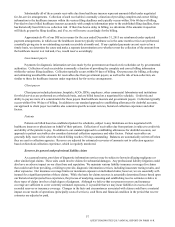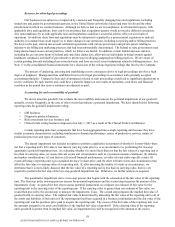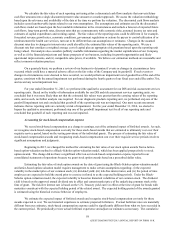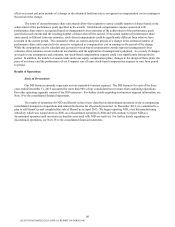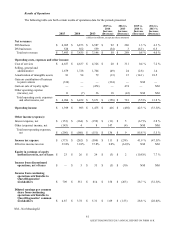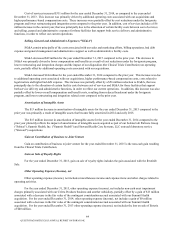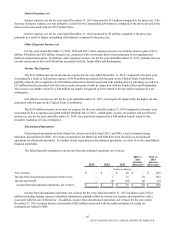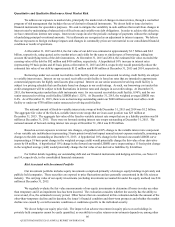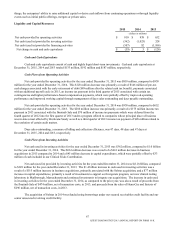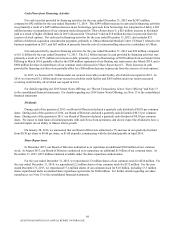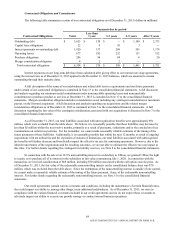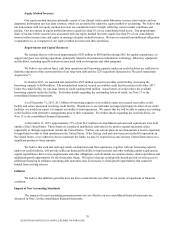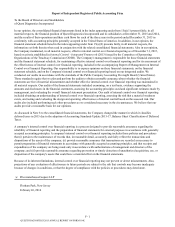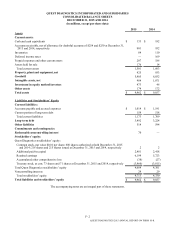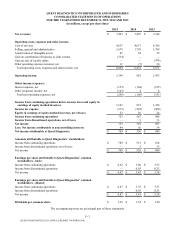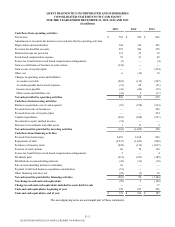Quest Diagnostics 2015 Annual Report Download - page 70
Download and view the complete annual report
Please find page 70 of the 2015 Quest Diagnostics annual report below. You can navigate through the pages in the report by either clicking on the pages listed below, or by using the keyword search tool below to find specific information within the annual report.66
Quantitative and Qualitative Disclosures About Market Risk
We address our exposure to market risks, principally the market risk of changes in interest rates, through a controlled
program of risk management that includes the use of derivative financial instruments. We do not hold or issue derivative
financial instruments for speculative purposes. We seek to mitigate the variability in cash outflows that result from changes in
interest rates by maintaining a balanced mix of fixed-rate and variable-rate debt obligations. In order to achieve this objective,
we have entered into interest rate swaps. Interest rate swaps involve the periodic exchange of payments without the exchange
of underlying principal or notional amounts. Net settlements are recognized as an adjustment to interest expense. We believe
that our exposures to foreign exchange impacts and changes in commodity prices are not material to our consolidated financial
condition or results of operations.
At December 31, 2015 and 2014, the fair value of our debt was estimated at approximately $3.7 billion and $4.2
billion, respectively, using quoted active market prices and yields for the same or similar types of borrowings, taking into
account the underlying terms of the debt instruments. At December 31, 2015 and 2014, the estimated fair value exceeded the
carrying value of the debt by $82 million and $416 million, respectively. A hypothetical 10% increase in interest rates
(representing 39 basis points and 45 basis points at December 31, 2015 and 2014, respectively) would potentially reduce the
estimated fair value of our debt by approximately $112 million and $108 million at December 31, 2015 and 2014, respectively.
Borrowings under our secured receivables credit facility and our senior unsecured revolving credit facility are subject
to variable interest rates. Interest on our secured receivables credit facility is based on rates that are intended to approximate
commercial paper rates for highly rated issuers plus a spread. Interest on our senior unsecured revolving credit facility is
subject to a pricing schedule that can fluctuate based on changes in our credit ratings. As such, our borrowing cost under this
credit arrangement will be subject to both fluctuations in interest rates and changes in our credit ratings. At December 31,
2015, the borrowing rates under these debt instruments were: for our secured receivables credit facility, 0.96%; and for our
senior unsecured revolving credit facility, LIBOR plus 1.125%. At December 31, 2015, the weighted average LIBOR was
0.4%. As of December 31, 2015, there were no borrowings outstanding under our $600 million secured receivables credit
facility or under our $750 million senior unsecured revolving credit facility.
The notional amount of fixed-to-variable interest rate swaps at both December 31, 2015 and 2014 was $1.2 billion.
The aggregate fair value of the fixed-to-variable interest rate swaps that are in an asset position was $23 million at
December 31, 2015. The aggregate fair value of the fixed-to-variable interest rate swaps that are in a liability position was $6
million at December 31, 2015. There were no forward starting interest rate swaps outstanding at December 31, 2015. The
notional amount of forward starting interest rate swaps at December 31, 2014 was $150 million.
Based on our net exposure to interest rate changes, a hypothetical 10% change to the variable interest rate component
of our variable rate indebtedness (representing 3 basis points) would not impact annual interest expense materially, assuming no
changes to the debt outstanding at December 31, 2015. A hypothetical 10% change in the forward one-month LIBOR curve
(representing a 18 basis point change in the weighted average yield) would potentially change the fair value of our derivative
assets by $8 million. A hypothetical 10% change in the forward one-month LIBOR curve (representing a 15 basis point change
in the weighted average yield) would potentially change the fair value of our derivative liabilities by $4 million.
For further details regarding our outstanding debt and our financial instruments and hedging activities, see Notes 13
and 14, respectively, to the consolidated financial statements.
Risk Associated with Investment Portfolio
Our investment portfolio includes equity investments comprised primarily of strategic equity holdings in privately and
publicly held companies. These securities are exposed to price fluctuations and are generally concentrated in the life sciences
industry. The carrying value of our equity investments (excluding investments accounted for under the equity method) was $14
million at December 31, 2015.
We regularly evaluate the fair value measurements of our equity investments to determine if losses in value are other
than temporary and if an impairment loss has been incurred. The evaluation considers whether the security has the ability to
recover and, if so, the estimated recovery period. Other factors that are considered in this evaluation include the amount of the
other-than-temporary decline and its duration, the issuer’s financial condition and short-term prospects and whether the market
decline was caused by overall economic conditions or conditions specific to the individual security.
We do not hedge our equity price risk. The impact of an adverse movement in equity prices on our holdings in
privately held companies cannot be easily quantified, as our ability to realize returns on investments depends on, among other
QUEST DIAGNOSTICS 2015 ANNUAL REPORT ON FORM 10-K



